The White Moon Gallery Presents

by Gwenhwyfar
© All original Material in this site is under copyright protection
and is the intellectual property of the author
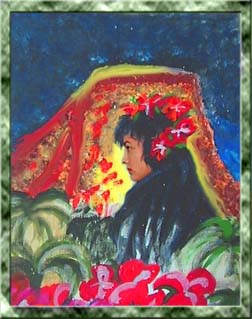
“Pele, Volcano Goddess” by Gwenhwyfar
|
Pele, the Hawaiian volcano goddess, once thought of herself as a goddess of water. The myth tells of how Pele led her people to a Landmass while searching for her own vocation. In one myth her mother gave her the ocean as a gift, surrounding the landmass and leaving only the mountain peaks exposed. In others, she is fighting with her sister Na-maka-o-ka-ha’I until finding Hawaii. There she creates her home at Kilauea out of her sea sisters reach. Pele believed herself to also be a goddess of water and proceeded to dig holes, only to uncover gushing rivers of lava. The thrill of the lava spoke to Pele and she embraced the element of fire. Her people recognized her as a fire goddess bestowing on her the titles of goddess of the volcano and Pele the Destroyer (5).
Even with a title as fierce as "Destroyer," Pele is considered a Mother Goddess. She contains within her both the destructive and creative powers of life. These powers are still very evident in Hawaii where her home volcano of Kilauea has been erupting periodically since 1983 (4:44). The creative force in Pele's nature is shown in the synchronization of the elements during the eruption process. All four elements work together. Earth and fire mix creating lava. Lava possesses water characteristics in the liquidity of its form, while air is represented by the billowing clouds of smoke during eruption. Air and water are also present in steam when the lava reaches the ocean forming new landmass. It is in this way that the Hawaiian archipelago was formed, and Pele credited with its creation (2:109).
|

Pele is a very jealous goddess. She is protective of her territory and has been known to punish those who would dare to steal stones from her sacred places. Many visitors to Hawaii's volcanoes leave her offerings in the form of ohelo berries, ohia lehua blossoms, taro, or kala root. She is even left bottles of gin by some. Even with the offering Pele's permission must be asked before removing one of her stones. Many use the rocks she gifts them with as protective amulets (2:109)(3). Pele's fury can be aroused by the breaking of taboos, so many Hawaiians respect Pele's jealous nature and leave her the offerings. State park rangers tell of seeing people out late at night on the volcanoes' edges worshipping the goddess. When reaching the scene all they find are the offerings (4:46).

|
Goddess Manifestations
|

|
Volcanic eruptions are only one manifestation of the goddess Pele. Pele is a living goddess, appearing to her people as a wise old woman bumming cigarettes, or as a surpassingly beautiful young woman, or as a little white dog. She is said to light cigarettes with a flick of her fingers and to dance in red robes around the rims of the fiery mountains. (6:250). Brown haired women are sacred to Pele, hair itself is sacred to her. Thin strands of lava floating about in the air during eruptions are referred to as Pele's Hair (4:46).

|
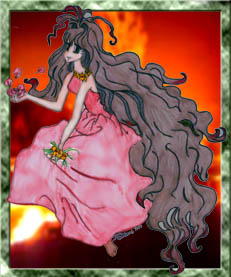
“Pele, Spirit of Fire” by Gwenhwyfar
|

|
Pele's different physical manifestations have different meanings. If she is dress in white then she is warning of ill health. If she is in red, then an eruption is imminent. Urban legend has young men stopping to pick up a beautiful young woman by the side of the road, only to have her vanish once inside the vehicle.

Modern Pele Worship
Many Hawaiian's still love and honor Pele as Kupuna (ancestress) and trace their lineage back to her. Her priests and priestesses are called Kaula Pele (Pele's prophets). She is very much alive to her followers. Many still perform rituals for the deceased to be accepted by Pele. Pouring rain and thunder are signs that their offerings have been accepted and the spirit of the dead has been accepted (4:45). I think this description by Scott Cunningham best brings to life the goddess' presence in the modern world:
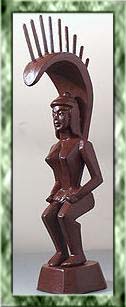
Image from Sacred Source
|
She is a tangible, physical presence in the volcano area of the island of Hawai'i. The ground is scorched, cracked, and blackened with lava. The scent of sulfur hangs in the air and irritates the throat. Steam eerily rises from the earth. During major eruptions, lava flows scorch the earth and , at the shore line, continue her ageless fight with her sister Na-maka-o-ka-ha as molten lava pours into the sea, causing tremendous explosions and mountains of steam (4:49).
|
Pele's awesome power and reputation for jealousy is a source of both fear and respect for her followers; however, there is a more light hearted side to Pele. She loves to surf, and is often seen surfing fiery crests of lava during eruptions. She is also said to occasionally take part in Papa Bolua, a game (contest) performed during the festival of Maki'hiki. The contest has two people racing each oter down the mountain on oiled sleds. Whoever could travel the farthest wins. Pele, whenever she participates, always wins (5).
Pele's worshippers know how to soothe Pele's quick temper through their songs, chants and prayers. Invoking Pele through music can be calming to both the petitioner and Pele. The people of Hawaii still "melo o Pele" (sing and chant to Pele and Kilauea). An example of one of the chants used for Pele is:
"E ola mau, e Pele e! 'Eli'eli kau mai! Ee-o-la-mao e
Pay lay ee! E-lee-e-lee-ka-my,"
This translates as "long life to you, Pele" (7:167).
Pele is a very powerful deity to work with. She lends her strength and passions to her followers. She is to be invoked when seeking protection, energy, strength, creativity or the ability to let go. Use the following Incense by Scott Cunningham while honoring Pele, or if wanting to add strength to any ritual, or just while performing any fire ritual.
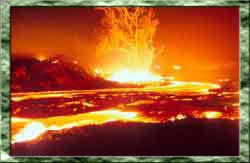
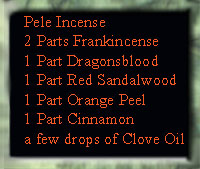


Pele Morning Ritual
|
I find myself many days waking up with the Goddess Pele. On mornings when I feel unenergized and need extra strength and vigor, I perform this ritual to Pele. First I make a cup of "Pele's coffee." This is really simple to make and can be altered to fit time constraints. The ingredients needed are brewed coffee (preferably a Kona blend), unsweetened baker's chocolate (or if in a hurry some sort of chocolate milk mix such as Hershey's syrup or Nestle quick), and cayenne pepper powder.
|
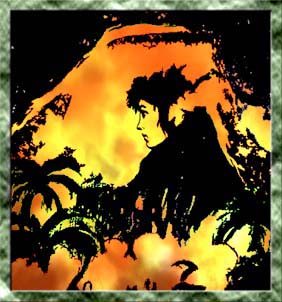
“Pele Profile” by Gwenhwyfar
|
First make your cup of coffee in a strength you normally drink. Next melt 1 block of baker's chocolate until liquid and set aside. Add a pinch, or dash of cayenne to the chocolate and mix well. Now add the spicy chocolate mixture to your coffee. If you normally add sugar to your coffee you may do so now, however, too much sugar will counter the cayenne pepper effect. If using an alternative to the unsweetened baker's chocolate then there will be sugar present already from the mix you chose and you will most likely not need to add a sweetener. If using a mix instead of baker's chocolate, add either two squirts of Hershey's syrup or two teaspoons of Quick mix directly to the brewed coffee, then add your cayenne pepper to the mug. Stir well.
Once stirred, I lean over my mug and breath in the strong spicy aroma. Then I invoke the goddess' strength to aid me for that day by chanting, "Fiery Pele, spirit of Fire, ignite my mind and guide me with your strength."

Works Cited
1. Cunningham, Scott. The Complete Book of Incense, Oils, & Brews. St.Paul: Llewellyn. 1989
2. ---. Cunningham's Encyclopedia of Crystal, Gem & Metal Magic. St.Paul: Llewellyn. 1988.
3. ---. Cunningham's Encyclopedia of Magical Herbs. St.Paul: Llewellyn. 1985.
4. ---. Hawaiian Magic and Spirituality. St. Paul: Llewellyn. 1994.
5. Myth and Mankind: Journey's through Dreamtime, Oceanian Myth. ed. Duncan Baird Publishers Castle House. Amsterdam: Time Life Books. 1999. (possibly out of print, I have seen bargain books in this series at my local Barnes&Noble)
6. Monaghan, Patricia. The New Book of Goddesses & Heroines . St.Paul: Llewellyn. 1981.
7. Brockway, Laurie Sue. A Goddess Is A Girl's Best Friend. New York: Perigee. 2002.
Graphic Credits
Frames, Tikki Graphics, Pele Incense and Title Graphic courtesy of Gwenhwyfar
Lava photos courtesy of Time Life Magazine
“Pele, Volcano Goddess” mixed media by Gwenhwyfar
“Pele, Spirit of Fire” mixed media by Gwenhwyfar
“Pele Profile” by Gwenhwyfar
Statue of Pele courtesy of Sacred Source
Back to Gallery
Join a School









